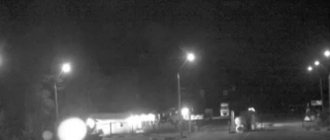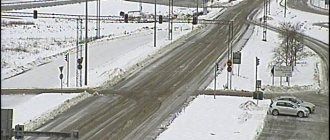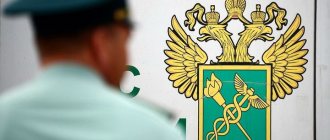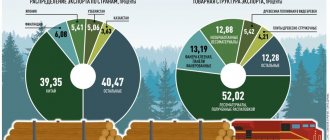Contacts and details
| Name | Customs post of the New Yurkovichi international checkpoint |
| Customs code | 10102040 |
| Customs clearance | produced |
| Parent's name | Bryansk customs |
| Short name | t/p MAPP New Yurkovichi |
| Border section | Russian-Ukrainian |
| Kind of transport | Automotive |
| Full address | 243046, Bryansk region, Klimovsky district, ter. International checkpoint Novi Yurkovichi |
| Telephone | +7 (48347) 2-11-37 |
| Fax | +7 (48347) 2-17-99 |
| [email protected] | |
| Website | https://ctu.customs.ru/folder/88805 |
| Working with ATA carnets | Yes |
| OKATO code | 15228 |
| SOATO code | 1115 |
t/p New Yurkovichi international checkpoint on the map
Other posts and customs in the Bryansk region
- Bryansk customs (10102000)
- Volodarsky customs post (10102010)
- Bryansk customs post (10102030)
- Novozybkovsky customs post (10102070)
- Pogarsky customs post (10102080)
- Customs post of the Troebortnoye international border crossing point (10102090)
- Alexandrovsky customs post (10102120)
- Fokinsky customs post (10102150)
- Customs post Pogar international border crossing point (10102170)
- Bryansk excise customs post (10009160)
See also: Bryansk region, Customs posts, Autoposts
Customs broker services
- Personal customs clearance specialist;
- We prepare and execute the necessary documentation - declarations, applications, various permitting forms, documents, reporting;
- Recommendations on HS codes for goods;
- Preliminary calculation of customs value and amount of advance customs payments;
- Drawing up DT projects and related documents;
- Document flow with customs;
- Submission of information at the request of the MAPPA Customs post Novi Yurkovichi;
- Representation of the Customer's interests in the customs authorities of the Russian Federation;
- Organization, if necessary, of preliminary customs inspection of goods and vehicles before submitting the DT;
- Drawing up a declaration of intent under the seal of the customs representative;
- Consulting in the field of foreign economic activity (FEA);
How to get there
by car: from Bryansk along the A-240 highway to Pochep, from Pochep along the highway to Starodub, from Starodub along the highway to Klimovo, from Klimovo along the highway to Novye Yurkovichi, from Novye Yurkovichi along the highway to the Novye Yurkovichi checkpoint.
GPS coordinates: 52.116411, 31.811110
Fire
More details
Three-breasted
More details
Krupets
Read more
Sudja
Read more
Grayvoron
More details
Nekhoteevka
More details
Shebekino
Read more
Rovenki
Read more
Bugayovka
Read more
Mamonovo
More details
Mamonovo II
More details
Bagrationovsk
Read more
Gusev
More details
Chernyshevskoe
More details
Border
More details
Soviet
Read more
Marine
Read more
Stasenki
Read more
Senkovo
Read more
Ezerische
More details
Pubis
Read more
Yukhovichi
Read more
Dolostsy
Read more
Kostrovo
More details
Baidakovo
Read more
Voronino
More details
Klinovoe
Read more
Ukleenka
Read more
Malye Kuliga
Read more
Shlyki
Read more
Blackbirds
More details
Pegs
More details
Types
More details
Makarenki
More details
Dubrovka
More details
Zaolsha
Read more
Kruglovka
More details
Village
More details
Odrino
Read more
Dungeons
Read more
Krasnaya Gorka
More details
Lyady
Read more
Bukharino
Read more
Rudashkovo
Read more
Bags
More details
Baevo
More details
Kovshichi
More details
Friendly
Read more
Sheino
Read more
Polishino
Read more
First of May
Read more
Okushki
Read more
Khotylevka
Read more
Volintsevo
More details
Semorzha
More details
Rubanovka
Read more
Starokadino
Read more
Cool
Read more
Sloboda
Read more
Selishchi
Read more
Offense
Read more
Mileikovo
More details
Krasnaya Raevka
Read more
Dubasno
Read more
Verevna
Read more
Kaskovo
More details
Oktyabrskoe
More details
See all borders with Russia
Share:
Price
One consignment of goods is understood as a consignment of goods sent at a time to the consignee using one waybill in one vehicle within the framework of one foreign trade contract.
| Type of work | Cost without VAT) |
| Carrying out customs operations and declaring goods of one consignment in import mode (IM 40): - consulting; — checking the package of documents provided by the Customer for customs clearance of one consignment (including shipping documents); — formalization of delivery documents, preparation, filling out the declaration form and electronic submission to the customs authority. | from 5,000 rubles |
| Carrying out customs operations and declaration for each subsequent consignment in import mode, if there are several consignments in one vehicle (IM 40): - consulting; — checking the package of documents provided by the Customer for registration of one consignment (including shipping documents); — formalization of delivery documents, preparation, filling out the declaration form and electronic submission to the customs authority. | from 4,000 rubles |
| Registration of each additional sheet of goods declaration, starting from the 5th (fifth) product in the import mode (IM 40). | from 450 rubles |
| Carrying out customs operations and customs declaration of goods of one consignment in export mode (EC 10): - consulting; — checking the package of documents provided by the Customer for one consignment (including shipping documents); — formalization of delivery documents, preparation, filling out the declaration form and electronic submission to the customs authority. | from 3,000 rubles |
| Carrying out customs operations and declaring goods of one consignment (other modes): - consulting; — checking the package of documents provided by the Customer for customs clearance of one consignment (including shipping documents); — formalization of delivery documents, preparation, filling out the declaration form and electronic submission to the customs authority. | from 10,000 rubles |
| Payment (additional payment) of any types of customs duties under one DT on behalf and on behalf of the Customer, using the representative’s own funds through terminal payment using a customs card/online service of the ROUND payment system. | from 3% of the documented payment amount (additional payment), but not less than 1,000 rubles |
| Assistance in obtaining a Declaration of Conformity with the CU TR for goods, as well as other permitting documents. | discussed individually |
PageNew Yurkovichi
With.
New Yurkovichi New and old Yurkovichi
New Yurkovichi is the center of the Novoyurkovichi settlement. The settlement includes the villages: New Yurkovichi, Starye Yurkovichi, settlements: Verbovy Vygor, Gladky, Mokhovye Lipki, Novy Svet, Svetly, Sinyavka, Chapel, Chernozemny Gorodok, Zeleny Kut, Ryabinovka, villages: Ivanovka, Rudnya-Tsata. In total, 962 people live in the settlement. The head of the settlement is Nikolai Petrovich Prokopenko. The village of Starye Yurkovichi has been mentioned since 1684 as an existing village within the Polish-Lithuanian Commonwealth, within the Russian Empire since 1772. Currently, this is not a very large village with a population of just over 300. On the territory of the Novoyurkovichy settlement there are 4 cultural institutions: Novoyurkovichy PSDC and Staroyurkovichy SDK, libraries in New and Stary Yurkovichy. Interest clubs and amateur associations operate at the PSDK and the library. Participants in amateur performances take an active part in events held in the area, and have also traveled to the city of Bryansk more than once to participate in the cultural program of the Klimovsky Metochion at the Svenska Fair. The book collection of the settlement's libraries amounts to over 15 thousand copies. The libraries serve more than 500 readers. For many years, the collective farm of the village of Novye Yurkovichi was headed by Vladimir Stepanovich Stefankov, the village tractor driver Alexander Danilovich Zaitsev was awarded the Order of Friendship of Peoples. Among the natives of the village of Bobariko are Anastas Lukich, who worked as the director of a metallurgical plant in Zaporozhye, Ivan Guznenok - an aircraft designer (he developed a braking pad for spaceships), Vladimir Ivanovich Prishchepa - the commander of a submarine, Vladimir Ivanovich Timoshenko and Vladimir Mikhailovich Konovalov - doctors. The place of worship for the villagers is the monuments to the liberating soldiers and fallen fellow villagers. Not far from the village of Novye Yurkovichi, located on the border of three Slavic states, youth festivals are held annually. The famous People's Friendship Monument, built in 1975, annually attracts thousands of people from three neighboring countries. The Friendship of Peoples Monument has long become the focus of all major events held jointly by residents of three border regions - Bryansk, Gomel, Chernigov, and now different states - Russia, Belarus, Ukraine.
Compiled by E. Makovey History of the village of New Yurkovichi
Name of the village Once upon a time, there lived an old hunter. And he had three sons: Yuri, Senka and Veselin. One day, when the sons were hunting an animal in the forest, their home was attacked by enemies. The father was killed. The house was burned down. The sons took revenge for their father, for the reproach. In the battle with the enemy they received wounds, well done, they went to the river. They washed off the blood, and the wounds immediately healed. It’s not for nothing that the river’s name was Zheveda, which means living water. The brothers settled not far from each other. They lived in harmony and harmony. In case of trouble, they came together to make it easier to cope with it. According to legend, their settlements were also named after the brothers. This is how they arose from Yurko - Yurkovichi, from Senka - Senkovka, from Veselin - Veselovka. There is also a legend about the brothers. The name of the villages Old and New Yurkevichi comes from the surname of the first settlers - the Yurkevich brothers. The old ones were founded by the elder brother, and the New ones by the younger brother. Historical background The village of Novye Yurkovichi, Klimovsky district, Bryansk region, is located in the southeast of the region. The distance from the regional center and the railway is 50 km. A federal highway passes through the village, which connects with Ukraine (Kyiv) and Belarus (Gomel). The local hospital is located 18 km from the village - in the village of Churovichi. Two kilometers from the village flows the Zheveda River, which runs along the state border with Ukraine, and the Rzhavets Creek, which separates the collective farm fields from the neighboring village of Starye Yurkovichi. Nine kilometers from the village, in the village of Krucha, the larger Tsata River flows. On the territory of the administration there is a customs service two kilometers from the village. A hotel complex and a gas station were built. First information about the village of Novye Yurkovichi In the southeast, the village is near the very border strip separating Russia, Ukraine and Belarus. This is New Yurkovichi. Here, as they jokingly say, the rooster crows for three republics at once. The first mention of the village of Novi Yurkovichi is in documents of the 13th century. These documents are stored in the central state historical archive of the BSSR, because previously the village belonged to the Staro-Yurkovichi volost, Gomel district, Mogilev province. The “Memorable Book” of the Mogilev province for 1912 reports that there were 6 fairs in the village. A real scourge for peasants were the devastating fires that set dozens of peasant farms around the world. So on March 6, 1882, 175 courtyards and 8 barns, 2 public houses burned down from careless contact with fire. The loss was 42,500 rubles. On May 11, 1896, also due to careless handling of fire, 40 peasant houses with property burned down, the loss amounted to 16,000 rubles. At that time it was a lot of money. And if we take into account that under the conditions of tsarism no help was provided to the fire victims, it becomes clear that such a terrible disaster fell on the shoulders of the already disadvantaged peasantry. In 1915, 2 streets and 10 barns burned down. In 1880 in the village. N. Yurkovichi had 254 peasant households and 1,487 inhabitants. The peasants were mainly engaged in arable farming. Handicrafts were not widespread, as evidenced by the following data: 2 people were engaged in tailoring, their earnings reached 15 rubles. per year for each. 2 people were engaged in shoemaking, their earnings were 10 rubles, 2 yards were engaged in the preparation of rims, hoops, blanks, pliers for clamps - their earnings were 25 rubles. in year. There were 3 blacksmiths in the village, their income reached 100 rubles. in year. 197 men were engaged in latrine trades.
In 1874, local peasant Laguto Philip opened an oil mill in the village, where 1 master and 1 worker worked. The gross income of this enterprise in 1881 was 250 rubles. The lands located around the village were owned by a large landowner - the nobleman Mr. Zhdanovich, who lived all the time in the cities of the empire, including in the city of Chernigov. The farmers negotiated the purchase of land with the managers of the landowner Zhdanovich. Archival documents indicate that the landowner took from 125 to 250 rubles for a tithe. The first time they negotiated was from 1902 to 1911. But the negotiations were interrupted, and after 1917, Zhdanovich’s further stay is unknown. Its lands were ruled by Vumenets and Gurevich (Jew). The second time the negotiations ended with a purchase agreement. The deed of sale for land, file No. 1100 for 1911, is located in the notary office of Chernigov. In 1912, the village of Novy Svet appeared, populated by immigrants from Novye Yurkovichi, and in 1914 - the village. Lipovka (now Ukraine). In the 30s of the XX century. it was the largest village in the Novoyurkovichi village council. It had 43 farms and was home to more than 200 people. The formation of a collective farm and the life of collective farmers In 1930, in the village. N. Yurkovichi organized the collective farm “Red militant”. At first, 33 families joined it. The first chairman was Andrey Antonovich Prus. Then the collective farm was headed by Kapran Mitrofan Kirillovich. Later, collective farms began to be organized: “Paris Commune” - the village of Sinyavki, “Novy Svet” - the village of N. Svet, “Krasnaya Rechitsa” - the village of Krucha, “The Bright Path” - the village of Verbovy Vygor, Gladky, “Svetly” - the village Svetly, collective farm “New Town” - Gorodok village. The average yield was 8.5-9 c/ha. They sowed: spring wheat, buckwheat, oats, millet, peas, beans, lupine, vetch, potatoes, cabbage. Before 1950, there were 9 small collective farms, the largest was “Krasny Boevik” with an area of 643 hectares, and the smallest collective farm “Svetly” - 193 hectares of arable land. In 1949, there were 121 cows, 270 horses, 97 oxen, 177 pigs and 44 sows, and 240 sheep. The milk yield per cow per year was 500–600 kg of milk. In 1950, collective farms united and created 3 large ones: “Shining Path” - Svetly, Gladky, V. Vygor, Gorodok - 1220 hectares. "Red Action" - p. New Yurkovichi, Zheveda village, Sinyavki village - 1380 hectares. “New World” - village N. Svet, Krucha - 690 hectares of arable land. They existed for 8 years, until 1958. The collective farm “Bright Path”, led by Ivan Mironovich Silchenko, developed most successfully, “New World” took second place and “Red Fighter” took third place. In 1957 bought equipment from the state. In April 1958 The second merger of the collective farms “Krasny Boevik” and “Novyi Svet” into one collective farm took place; it began to be called “Soviet Russia”. Nikolay Fomich Kuteko was elected chairman of the collective farm, and Vladimir Stepanovich Stefankov began working as an agronomist, who then headed the farm for many years. The collective farm had 3 tractors DT - 54, 3 Belarusians, 1-DT-14, 3 self-propelled combines S - 4, a complex thresher MK - 1100, 8 vehicles. The milk yield was 1250 - 1300 kg of milk per cow, but the collective farms had no profit. In November 1959, the last merger of two collective farms into one “Soviet Russia” took place. There were 3296 hectares of arable land, 455 hectares of hayfields, and 203 hectares of pastures. In 1960 the yield was 7.8 c/ha of grains, potatoes – 72 c/ha. There were 760 heads of livestock, including 318 heads of cows, 540 heads of sheep, 230 heads of horses, 720 heads of pigs. The milk yield was 1400 kg per year. In 1967, the collective farm had 9 tracked tractors, 8 Belorusovs, 2 DT-20, 7 self-propelled combines SK-3 and SK-4, 6 grain cleaning machines, 1 dryer, 15 motor vehicles, 1 fuel tanker, 1 passenger car. In 1967, the anniversary year of the 50th anniversary of Soviet power, workers with increased energy made life richer and more beautiful with their labor. The yield on the collective farm increased every year, and the productivity of the dairy herd increased. Life was rich and interesting. Collective farmers joined socialist competition. All village residents know the names of leaders in agricultural production. These are advanced combine operators: Pauk Nikolai Nesterovich, Pauk Nikolai Nikolaevich, Kravchenko Nikolai Ivanovich. Milkmaids: Zaitseva Tamara Khrisanovna, Tupitsa Nina Ustinovna, Fomenko Nadezhda Ivanovna. Potato growers of the farm: Laguto Vasily Grigorievich, Zaitsev Mikhail Matveevich. For decades, the collective farm occupied leading places in the region in many respects. In the late 80s - early 90s. The farm began to experience financial difficulties. Growth rates began to fall sharply. In 1996, the collective farm “Soviet Russia” was renamed the collective farm “Russia”. On March 7, 2002, the Rossiya collective farm was renamed Zheveda LLC. Fixed assets were transferred to MUP RAO Klimovskoye. The collective farm ceased to exist
In 1954 or 1955 the church was destroyed. Information about this event has been preserved.
Memories of the destruction of the church in the village. New Yurkovichi Zaitseva Anna Nikiforovna: “Our church was wooden, painted white. She stood on the highest place and was visible even 15 km from the village of Usokh, which is located in Belarus. Our collective farmers went to this village to harvest peat. The church was destroyed, I don’t remember exactly, in 1954-1955. They hooked 4 tractors to four corners with cables and pulled them in different directions. When the church collapsed, a sound like an explosion could be heard far away. Several girls stood and looked at the ruins and they saw a woman and an old man with a white beard who were crying loudly. The children told the adults. When they came to the ruins, they saw no one. And then people believed that it was the Mother of God and Nicholas the Pleasant. Before the temple was destroyed, people took home icons, church utensils, and books. At first, Baba Gapa took the wooden cross and icons; she lived alone and on major holidays women began to come to her, conduct services, and pray. “To hold a candle” is the name of the house where there is a large wax candle, a cross, icons and a service is held.” At the time of the memories, the candle is in the possession of the oldest woman, a widow - Konoplyanaya Evdokia Prokopovna, born in 1913. In 1958, the club and library moved to new premises. The club had a stationary film installation, a television, a radio, a button accordion and an accordion, and string instruments. From that time until 1995. the head of the library was Timoshenko A.A. Since 1966, Vasily Grigorievich Konoplyany became the head of the club. There were amateur art groups. A lot of work was done to promote the materials of the 23rd Congress of the CPSU and work to celebrate the “50th anniversary of Soviet power.” Evenings and meetings were held with participants in the civil war and former partisans. In 1967, the library had about 6,000 books and about 700 readers. In 1967, on the occasion of Victory Day, a monument to those who fell in battle in the war of 1941-1945 was erected. And the monument was erected to the chairman of the village council Pryadko S.P. and the secretary of the village council Pryadko Ya.M. - killed with fists. The well-being of village residents is growing every year. In the early 60s, televisions, radios, washing machines, and refrigerators appeared. Local radio was conducted. In 1985, a new building of the rural House of Culture was built, housing both the rural library and the museum.
Yurkovichi.
Once upon a time, there lived an old hunter. And he had three sons: Yuri, Senka and Veselin. One day, when the sons were hunting an animal in the forest, their home was attacked by enemies. The father was killed. The house was burned down. The sons took revenge for their father, for the reproach. In the battle with the enemy they received wounds. Well done, let's go to the river. They washed off the blood, and the wounds immediately healed. It’s not for nothing that the river’s name was Zheveda, which means living water. The brothers settled not far from each other. They lived in harmony and harmony. In case of trouble, they came together to make it easier to cope with it. According to legend, their settlements were also named after the brothers. Then people began to move in with them. And so three villages arose: from Yurko - Yurkovichi went, from Senka - Senkovka, from Vaselin - Veselovka. The Old and New Yurkovichi are located in the Bryansk region. Both villages are ancient. New Yurkovichi is mentioned in the 13th century. This means that the Old Ones are even more ancient. There is a legend about them and also about the brothers. The name comes from the surname of the first settlers - the Yurkevich brothers. The Old Yurkovichi were founded first by the elder brother, and the New ones by the younger brother. Nowadays these villages are located at the junction of Russia, Ukraine and Belarus. In Ukraine, Senkovka is located next door, in Belarus - Veselovka. Three villages exist. And the legend about the three good brothers? So was it or not? Who knows? If it was invented, it was not in vain. An earthen hill rises above the clear river Zheveda. There is a majestic monument on it. Three white pylons soared high into the sky. In their upper part are the coats of arms of the RSFSR, BSSR, and Ukrainian SSR. The lower part of the pylons is surrounded by a bronze ring. There are bas-reliefs on it - pages of the common history of three fraternal peoples. The Friendship Monument, visible for many kilometers around, was opened during the celebration of the thirtieth anniversary of the Victory of the Soviet people in the Great Patriotic War of 1941-1945. Legend. Monument. The symbols are beautiful, calling for unity and brotherly friendship. Friendship, what could be stronger, more beautiful.
Operating procedure
- Request. You leave a request in any convenient way: by phone, email or through forms on the website.
- Consultation with a specialist. We call you back and find out your task in the field of foreign economic activity and inform you of the price for customs clearance.
- Signing the contract. Agreeing on the terms of cooperation and signing the contract.
- Preparation of documents and certificates. Collection and preparation of the necessary permits for the import or export of your goods.
- Customs clearance. Submitting a declaration, resolving disputes and attending inspections and inspections.








